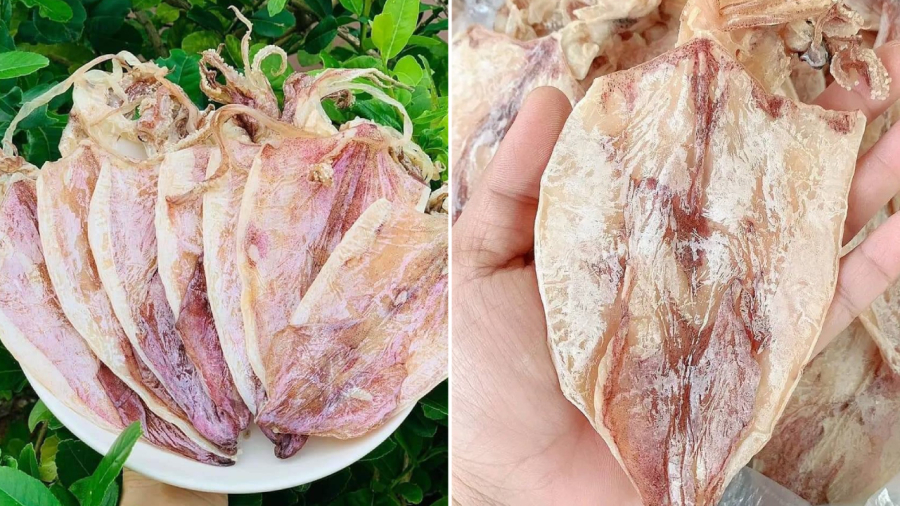Tips for Choosing Delicious Dried Squid
Dried squid is a beloved seafood delicacy among many. It can be grilled to perfection and then shredded, often enjoyed with chili sauce or other dips according to preference. Additionally, dried squid is versatile and can be used in stir-fries, stews, and soups.
When selecting dried squid, it’s essential to know how to choose a quality product that is free from chemical preservatives.
Color of the Squid
Opt for squid with a natural light pink or reddish-brown hue. This coloring indicates freshness and quality. The best dried squid will also have a whitish powder on its back, a sign that it has been dried properly.
Avoid squid with overly dark or abnormal black spots. This may indicate that the squid is old or has been treated with chemicals.
Checking the Aroma
Fresh, high-quality dried squid will have a distinct, natural seafood aroma. Refrain from purchasing squid with a strong, strange, or chemical-like smell, as this could indicate the presence of harmful preservatives.

Inspecting the Eyes and Body
Clear, transparent eyes are a sign of good quality. Additionally, the body of the squid should be straight, without any bends or breaks. This indicates proper handling, natural drying, and no chemical intervention.
Dryness and Flexibility
Naturally dried squid will have a moderate level of dryness. Avoid squid that is too dry and rigid or too soft. Ideally, the squid should feel dry to the touch without any stickiness.
However, it’s important to note that squid shouldn’t be too dry, as this can make it tough and difficult to eat. Over-drying or high-temperature drying can lead to this issue.
Size of the Squid
Look for squid of uniform size, with thick and firm meat. The ideal size may vary depending on the species of squid used for drying. Larger squid may not always have sweeter meat, so size isn’t the sole indicator of quality.
Squid caught by hook tend to have thicker bellies and, consequently, sweeter meat than squid caught by net.
Thin squid may be of inferior quality and more prone to burning during grilling, so it’s best to avoid them.
How to Store Dried Squid
Proper storage of dried squid is crucial to maintain its freshness and prevent bacterial or mold growth. Wrap the squid tightly in clean, dry paper or place it in an airtight bag. Then, store it in the refrigerator to keep it fresh for about 1-2 months.
For longer storage, consider freezing the squid, which can extend its shelf life to 6-12 months without sacrificing quality.
At room temperature, dried squid can be stored, but ensure it is tightly wrapped and placed with a moisture-absorbing packet to prevent moisture buildup, which can lead to spoilage.
Regularly inspect the squid for any changes in color, texture, or smell. If it becomes slightly damp, sun-dry it to restore its dryness. However, if it develops a slimy texture or shows signs of mold, discard it for food safety reasons.
The Secret to Perfectly Grilled Squid
For the best grilling results, marinate the squid in beer for about 10 minutes before cooking. This helps tenderize the meat, preventing it from becoming too tough or dry. Beer also enhances the squid’s flavor and eliminates any fishy smell. If you don’t have beer, coconut water or clear liquor can be used instead.
After marinating, blot the squid dry with a paper towel and then grill it using your preferred method: alcohol lamp grilling, charcoal grilling, gas stove grilling, air fryer, or oven baking.
Separate the head and body of the squid before grilling, as they have different cooking times. Leaving them attached will result in uneven cooking.
When using an alcohol lamp for grilling, opt for 90-proof colorless alcohol, which burns cleanly and safely. Pour the alcohol into a heat-resistant dish or specialized grilling equipment, place the squid on top, and carefully ignite the alcohol. Use long chopsticks or tongs to turn the squid, ensuring even cooking without burning.
If you’re grilling larger squid and run out of alcohol before it’s fully cooked, add more, but only after the initial alcohol has burned out. Never add alcohol to a flame, as it can lead to dangerous flare-ups.
For oven baking or air fryer cooking, set the temperature to 160°C and cook the squid for about 4-5 minutes.
When using a gas stove, use tongs or chopsticks to turn the squid frequently to ensure even cooking and prevent burning.
The Ultimate Guide to Expired Sunscreen: Spotting Signs and Proper Storage
The sun’s rays can be harsh on your skin, and their damaging effects are often underestimated. The harmful UV rays can cause more than just a sunburn; they accelerate skin aging and increase the risk of skin cancer. It is crucial to understand that sunscreen alone might not provide adequate protection. Its effectiveness can diminish over time, leaving your skin vulnerable to sun damage, premature aging, and an elevated risk of skin cancer.






































